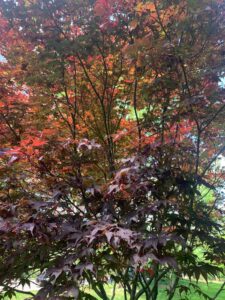Why Saving Insects Should Matter to You

A Japanese Maple in Homeland
It’s no secret that nature can liven up suburban areas, bring in people and build a community. For years, people have been planting flowers, trees, bushes, etc. Although any plantings can have benefits, have we been smart with what we are planting? That question can be very confusing to someone who isn’t familiar with native and non-native plants.
Essentially, a non-native plant is a plant that has been introduced from a different region. Unfortunately, these plants are very common. Walking through the Homeland neighborhood of North Baltimore, I noticed an abundance of Japanese Maple trees. The reason this tree is problematic is because it holds little to no ecological value. While the Japanese Maple plays host to invasive species such as the Japanese Maple beetle, it does very little for the region’s numerous native insects.
For comparison, a mature oak tree will host over 540 different species of moths and butterflies in their caterpillar stage. The reason this is important is that in an ecosystem, the base level of energy in a food chain comes from plants. The bugs eat the plants, some other predator eats the bugs, and so on. With a non-native tree, however, we are missing out on energy that can be passed up through the food chain. The Japanese Maple may host many more species of bugs in Japan, but not here.
In the book, Bringing Nature Home, Doug Tallamy mentions how important insects are in our ecosystem. “I cannot overemphasize how important insect herbivores are to the health of all terrestrial ecosystems. Worldwide, 37 percent of animal species are herbivorous insects. These species are collectively very good at converting plant tissue of all types to insect tissue, and as a consequence they also excel at providing food - in the form of themselves - for other species. In fact, a large percentage of the world’s fauna depends entirely on insects to access the energy stored in plants.” (Chapter 2, Page 21).
The main point of this quote is that the overall importance of insects in our ecosystem is bigger than most people think. They are absolutely essential to the food chain and without them, we would cease to have the reptiles, birds, and mammals that rely on them. The key issue is, if we continue to replace native plants with non-natives, we will remove the only food source available to our native insects. I understand that non-native plants may look beautiful in a front yard, but they aren’t supporting nearly as many insects as a native plant could.
Before my internship with NeighborSpace, I had a broad understanding of native and non-native plants, how the food chain worked, and the importance of insects. What I did not realize was that the beautiful plants that so commonly adorn our front yards were directly responsible for the decline in native insects and all of the animals they support.
Article by Harry Deller, Intern
Very good article.
As native plants can be harder to come by, I suggest that folks ask for native plants specifically at their favorite nurseries. If we ask for them they will supply them. Blue Water Baltimore does yearly native tree and plant giveaways.
I think it would be interesting to muse on the esoteric value of the subtle beauty of native plantings, including the lovely sounds of the native insects and creatures at work. They may not be as flashy as the non-native plants but they have another beauty, one that speaks more to the soul, one that we are all sorely missing in our lives.
Sometimes it is indeed the non-native tree that harms, but mostly it is the lack of native trees that is the issue as you so succinctly described.
Thanks and great job.
Well put. Thank you for your reply. I’m glad you enjoyed Harry’s article!